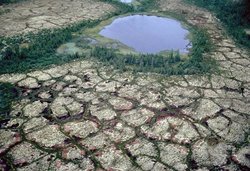As previously stated, there are three different types of Mechanical Weathering. Ice wedging only happens in cold climates. This type of mechanical weathering occurs when water seeps into cracks in rock, then freezes. When that water has frozen, it's volume increases by almost 10%, thus creating pressure on the surrounding rock. Whenever the water thaws and freezes again, the cracks in the rock widen and deepen. Eventually this process splits the rocks apart. Abrasion is the grinding and wearing away of rock surfaces through the mechanical action of other rock or sand particles. It is caused by gravity, running water, and wind. Gravity forces loose soil and rocks to move down the slope of a mountain or hill, causing the rocks to break into smaller pieces as they fall. Running water carries particles of sand or rock that scrape against each other and against stationary rocks, the outer area then becomes weathered by abrasion. Wind lifts and carries small particles, hurling them against surfaces, such as rocks. While the smaller, airborne particles strike the rock, they wear down the surface. |
 Organic activity is when something other then the other two types of mechanical weathering occurs. Such as, animals digging, roots of plants causing cracks to form, or worms that move the soil to expose new rock surfaces to mechanical weathering as well as chemical weathering.  |
|